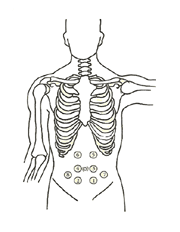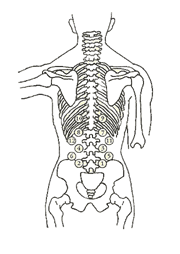Japanese Acupuncture Techniques - Kyukaku (Cupping)
Kyukaku (cupping) is used within a number of acupuncture styles. This section describes the use of cupping within a Japanese Acupuncture framework. A general description of cupping may be found in our "What is Cupping?" article. The information presented below discusses basic theory behind the technique, guidelines for applying the technique and examples of clinical use. Some of the techniques listed here require significant amounts of training to be performed correctly and should only be performed by practitioners who have been trained properly.
- Clinical Usage:
- Releases muscle tension and relives Blood stasis
- May also be used to move cold/damp
- Cupping Methods:
- Leaving/Retaining Cup
- Useful for pain management, loosens tight muscles
- Retain cup for 1-10 minutes depending on patients condition & constitution
- Moving/Sliding Cup
- Useful for Blood stasis a/or moving stagnant Qi
- Used in Japan for face lifts - small cups with very light pressure slid in an upward motion on the face
- Momentary Cupping
- Useful for weak a/or deficient patients
- Also useful for an "acute" contusion (draws local congestion from the area, apply the cup on the contusion and burn chinetsukyu on top after removing the cup - repeat 3 times or so until the sensation of pain is relieved)
- Cupping over a acupuncture needle
- Useful for chronic pain a/or bi syndromes
- Can be done locally or distally depending on the amount of pain a/or inflammation in the area
- Retain cup for approximately 10 minutes
- Cupping with bloodletting
- Useful for blood stasis a/or pain
- Prick a vascular spider or a stasis that has formed and place the cup over the area
- May also use the Ranshi Ho technique - place the cup on the skin, leave for about 30 seconds, remove, lancet the cupped area multiple times and then replace the cup
- Precautions and Contraindications:
- Not on the abdomen/sacral area during pregnancy
- Not on contraindicated points
- Not on areas with an inflammed organ
- Not on inflammed areas in general (can cup distally a/or around it)
- Not on patients with cardiac disease a/or aneurysms
- Not on patients with extreme fatigue a/or anemia
- Not on patients who have just finished exercising or taking a hot bath or shower
- No sliding cups over the spine, moles or other skin abnormalities
- General Guidelines:
- Deficient patient or weak pulse - use 2-3 cups w/less suction for less time (20 seconds to 2 minutes)
- Excess patient - use 7-10 cups w/more suction for more time (5-10 minutes)
- Removing Cups
- After removal perform 1 round of Chinetsukyu or use the tiger warmer on the cupped area
- If using pump cups clean them with alcohol, unless you have performed bloodletting then use a 9:1 bleach solution
- Patient reactions
- Some patients may feel too light headed or chilled, in this case use chinetsukyu on GV 14, GV 20 a/or ST 36
- As always, communicate with the patient about the marks left by cupping, some of which may stay for 2 days to a couple of weeks
- Specific Techniques:
- Skin diseases anywhere on the body (some also use this tx for repeated miscarriages - inbetween pregnancies) - perform cupping over the naval w/mild - moderate pressure, retain for 2-3 minutes, can repeat up to 3 times
- Disorders of the entire body - GV 14 & GV 12
- Respiratory disorders - UB 12, UB 13, UB 20, LU 1 & CV 17
- Lumbar pain - GV 4, UB 23, UB 20, GV 3, UB 37 & ashi "sensitive" points
- Dermatological disorders - UB 12, UB 13, UB 18, UB 20 & ashi points
- Chronic Constipation
- Works very well if done on a daily basis (front day 1, back day 2), but can also be performed within one treatment
- Cup on the abdomen first, retaining for about 10 minutes

- Perform Bunshi Shiroda's total body treatment
- Cup the back points, retaining for about 10 minutes

Sources and More Information
The information on our site is drawn from our own lecture notes and clinical experience. The following lecture notes were used within this section:
- Iuliano, Diane: New England School of Acupuncture, Extraordinary Vessel Techniques Lecture Notes
- Kuwahara, Koei: New England School of Acupuncture, Advanced Japanese Techniques Lecture Notes